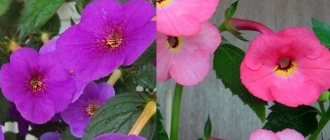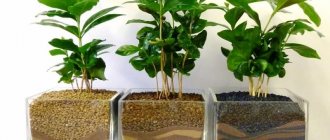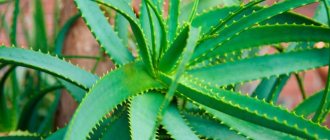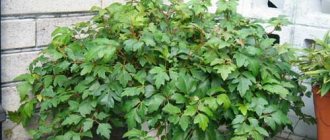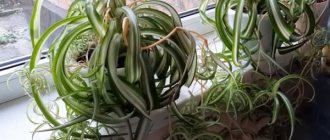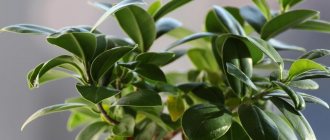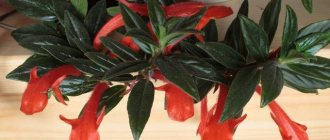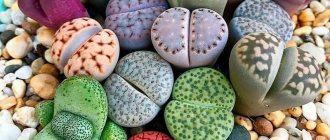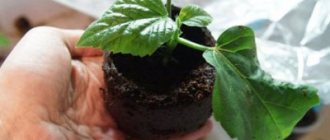Achimenes Limoncello is a perennial, indoor flower with a period of winter dormancy. Translated from ancient Greek, it is interpreted as “Goddess of Heat.” This unique plant belongs to the Gesnerev family.
Achimenes limoncllo is an erect, large-flowered variety. Characteristics:
- double plant (the petals do not all open completely);
- color from bright yellow to orange;
- corolla and rhizomes white;
- narrow two-bladed cup.
The flower has an amazing property: if it has comfortable conditions, a crimson color appears on the flower. Due to the lush flowering and large flowers (up to 5 centimeters), the plant needs support. Flowering lasts from 3-4 weeks. As the flower fades, it turns pale. This is a shade-loving plant that requires careful care.
Features of Achimenes
Achimenes is classified as a member of the Gesneriaceae family. This is a herbaceous perennial native to South and Central America. It has erect or drooping shoots that are weakly branched. In color they can be dark green or reddish. Their roots are scaly in the form of rhizomes, similar in appearance to fir cones.
The leaves are petiolate, oblong in shape, have jagged edges and a sharp end. The color can be green, dark green, with a pink or purple tint. The lower plate is pubescent.
Did you know? The largest sculpture of fresh flowers in the world was made in Ecuador in 2022. Almost 564 thousand roses were spent on its creation. 1.5 thousand local residents worked on it.
Achimenes blooms for a long time - from May to October. When favorable conditions are created and quality care is provided, it can bloom twice a year. Its flowers are paired or single, axillary, have 5 petals and a tube-shaped corolla.
Achimenes are suitable for decorating various interiors. They are grown on window sills, shelves, in flowerpots and hanging baskets as hanging and cascading plants.
Plant differences
Achimenes differ in the following characteristics:
- Type of shoots - there are types in which they grow upward (erect), and there are those in which they droop (ampeloid).
- Bush height - various species, varieties and hybrids form bushes with a height of 30 to 50 cm.
- The size of the buds is small, medium and large, reaching a diameter of 2.5 to 6 cm.
- The color scheme of the buds - the petals can be pink, purple, white, red, yellow, orange.
- Level of doubleness of flowers - petals are smooth, semi-double and double.
- Flower shape - during flowering, round, long, bell-shaped buds are formed.
The best plant varieties with descriptions
Today there are over 50 varieties and a large number of hybrid forms of Achimenes.
We invite you to get acquainted with the most popular of them:
- Achimenes mexicana. The height of the bush is up to 50 cm. The flowers are large - up to 5 cm in diameter. The color of the petals is different: white, purple, pink.
- Achimenes candida . Characterized by bushes up to 40 cm high and red shoots. It blooms profusely with small white flowers with a yellow throat.
- Achimenes fimbriata. The bush grows up to 30 cm. It has erect or creeping branches. The flowers are white.
- Achimenes grandiflora. Produces tall bushes up to 60 cm and large red flowers.
These are the main varieties, by crossing which it was possible to obtain the variety of Achimenes that exist today.
Did you know? The largest chandelier made from fresh flowers was made in Singapore. Its height is 17 m, length is 10 m. To make it, 260 students, schoolchildren, gardeners, and park employees were involved. The chandelier was included in the Guinness Book of Records.
A very interesting series of hybrids from breeder Serge Saliba.
These include:
- Queen of Lace. The bush grows compact. It can also be grown as a hanging plant. The flowers are large, with double petals of pink color with a lilac tint.
- Made in Heaven. A variety with a compact bush, erect shoots, small, narrow and long leaves, large double flowers of lilac color.
- Aurora Charm. A very beautiful hybrid with a small upright bush and flowers of original shape and color. They are wavy and pink. A star of a darker shade is visible in the center.
- Najuu . Bush variety with erect shoots. It has medium-sized white flowers with a beautiful throat design - it is yellow with brown splashes.
- Bianco Natale. A large plant with large double white flowers. Possible purple tint.
- Anastasia. Recognizable by its small bushes and abundant pink blooms.
- Аbendrot. Terry type with yellow petals. Thanks to its drooping shoots, it can be grown as a cascade or hanging plant.
- Painted Lady. An ampelous plant that blooms with pink flowers, the center of which is yellow with purple specks.
- Sagittarius. Miniature small-flowered hybrid with erect shoots. Blooms pink.
- Amie Saliba Improved. A beautiful flowering indoor plant with medium double buds of orange color.
- Lena Vera. Compact, profusely flowering hybrid. Flowering beige.
- Genesis. Characterized by abundant flowering. The bright purple flowers do not open completely - the petals in the center remain closed.
- Mary Poppins. Miniature hybrid achimenes with orange flowers.
- Venice. A hybrid with small bushes and leaves, medium-sized purple flowers.
- Saint Malo . Terry variety of lilac-blue color. Characterized by compactness and abundant flowering.
- Alter Ego . A hybrid variety with tall, well-branched bushes and large blue-violet flowers.
The following varieties of Saliba selection also deserve attention:
- violet and blue-violet : Poseidon, Plum Orchard, Nana Renee, Summer Rain, Vie en Bleu, Fluffy Wambler;
- yellow : Cytro, Strawberry Lemon, Limoncello, Hot Spot, Amie Saliba, Honey Queen, Yellow Fever, Hugues Aufray, Sun Dance, Santiano;
- orange : Terracotta, Orange Orchard;
- lavender : Champs de Lavande, Shy Sun;
- white : Summer Clouds, Icy Volga, Tamara Khorkina;
- red : Petite Fadette, Lady in Black, Vanity.
Separately, it is worth noting the pink-flowering hybrids Vie en Rose, Konrad Michelssen, Mad Parrot, Arletta Pink, Ice Tea, Boehme, Silvia Cagnani, Etienne Andersson, Last Dawn.
Hybrids of other breeders are also of interest:
- Himalayan Sunrise. Forms an upright bush. Blooms white with a yellow tint and lemon pharynx.
- Red Elfe. A small plant with erect branches and red flowers.
- Summer Festival. Large-flowered variety. Forms a tall, erect bush. Blooms pink.
- Rosy Frost . Semi-ampelous bushes grow medium in size. The petals are painted pink with a white spot according to class=”aligncenter” width=”874″ height=”502″[/img]
- Elegance. It is characterized by very large beet-colored flowers with a yellow center dotted with brown streaks.
- Blueberry Ripple. Large-flowered variety. Translated, its name sounds like “blueberry ripple.” It has large flowers with wavy edges of a pink-violet hue and a yellow mark at the throat.
- Tetra Verschaffelt. A plant with drooping shoots and large white flowers, painted with a purple mesh and decorated with a yellow spot near the throat.
- Peach Blossom. Indoor culture with pastel pink flowering and ampelous shoots.
- Lavender Fancy. Forms compact bushes with lavender-purple flowers that look beautiful against bright green foliage.
- Yellow Beauty. It has stiff shoots, dark foliage with jagged edges, yellow petals with brown streaks at the entrance to the throat.
- Rainbow Warrior. Bush, abundantly flowering variety. Flowering purple.
- Sabrina _ Compact variety with medium-sized coral-pink flowers.
- Purple Triumph. Blooms profusely purple with a lavender tint. The surface of the petals is textured. It grows as a bush.
- Glory. It is distinguished by its compactness and abundant flowering of a coral shade.
- Ambroise Verschaffelt. An ampelous plant with large white flowers painted in a purple mesh pattern.
Achimenes Limoncello: description
Achimenes limoncllo is an erect, large-flowered variety. Characteristics:
- double plant (the petals do not all open completely);
- color from bright yellow to orange;
- corolla and rhizomes white;
- narrow two-bladed cup.
The flower has an amazing property: if it has comfortable conditions, a crimson color appears on the flower. Due to the lush flowering and large flowers (up to 5 centimeters), the plant needs support. Flowering lasts from 3-4 weeks. As the flower fades, it turns pale. This is a shade-loving plant that requires careful care.
Features of care and cultivation
Almost all Achimenes are distinguished by their unpretentiousness and undemandingness to special growing conditions. To achieve maximum decorativeness from the plant, abundant and long-lasting flowering, you must adhere to the recommendations below.
Optimal conditions of detention
Achimenes needs bright, indirect light. The best growing location is windows facing west and east. The plant needs to be shaded from direct sunlight.
Achimenes develops well at warm temperatures in the range of +22...+25°C. During the process of active growth, you need to ensure that in the room where the indoor crop is growing, the thermometer does not fall below +20°C.
Important! If you have chosen varieties with dark leaves, then they need more light. Achimenes with light or variegated leaf color can tolerate partial shade.
In summer, it is advisable to take the achimenes out into the fresh air - onto the terrace, balcony, loggia. But it is important to control that it is not exposed to sudden temperature changes and does not freeze at night.
In winter, Achimenes begins a period of rest. At this time, the temperature will need to be reduced to +10...+15°C.
Humidity needs to be high - not lower than 60%. The air is humidified by installing a humidifier or placing the pot on a tray with wet pebbles or expanded clay. Spraying is not recommended for this plant.
Video: Growing and caring for Achimenes at home
Watering and fertilizing
In summer, Achimenes is moistened abundantly. The next watering is carried out when the top soil layer dries out. Check whether the flower is watered enough by sticking a stick into the soil - the soil should be moistened 2 cm deep.
Achimenes is watered in the classic way at the root, in a tray, or using the wick method. For humidification, use soft, settled, filtered or collected water after precipitation, heated to room temperature.
Video: How to water Achimenes
Starting in October, the amount of watering is gradually reduced. In winter they should be scarce. 2-3 large spoons of water per week will be enough.
In order for the plant to have good health, stable growth and development, long and abundant flowering, it needs to be fed periodically. From late March to mid-September, commercial fertilizers designed for flowering indoor crops are applied.
We advise you to get acquainted with such decorative flowering indoor plants as: mini phalaenopsis orchid, tulip geranium and chic poppy violet.
Trimming
To form a lush bush, you need to pinch. It is first produced when 3 pairs of leaves form on the shoot.
In the spring, pruning is done for sanitary purposes. Remove damaged, diseased, old shoots.
During flowering, faded buds are picked off. This will stimulate the appearance of new flowers.
Video: Pinching Achimenes
Transfer
Replanting indoor crops must be done in the spring of each year, at the end of the dormant period. You should first select a wide and shallow pot. A third of it should be occupied by the drainage layer. Expanded clay, pebbles, coarse sand, and broken bricks are used as drainage.
Achimenes are planted in light soil. You can purchase it in a store or make it yourself by mixing leaf soil (3 parts), turf soil (2 parts), peat (0.5 parts) and sand (1 part). It is also advisable to add sphagnum moss and charcoal in small quantities.
Important! The purchased substrate does not require pre-treatment before planting.
Soil made independently must be disinfected: calcined in the oven (microwave), poured with a solution of potassium permanganate, or frozen twice. The transplant procedure is as follows:
- The plant is removed from the old pot.
- Carefully clean the rhizome from the soil.
- Inspect the roots for damage and rot. If necessary, trim and process the sections.
- Place drainage at the bottom of the new container.
- Sprinkle it with soil.
- Place a flower in the center of the container.
- Distribute the roots.
- Cover the rhizome with soil, leaving 1.5–2 cm from the edge of the pot.
- Light compaction of the top soil layer is carried out.
- Water with warm soft water.
The first watering after planting is carried out when shoots appear.
Video: Transplanting Achimenes using the transshipment method
Reproduction methods
Achimenes is propagated at home in 2 ways:
- Rhizomes.
- By cuttings.
Per year, rhizomes can produce from 3 to 5 children, from which adult plants can be grown.
They are separated when the rhizome is still dormant, that is, in February-March. The rhizome is removed from the ground and divided into several parts. Each part is planted in a separate container with a light substrate. Each rhizome can be divided into 2–3 parts. The cut areas require treatment with crushed charcoal. In summer, cuttings are carried out. Select strong young shoots and cut off 10–12 cm pieces from them. Each part should contain 1–2 internodes. The cuttings are then placed in water for rooting. The fluid is completely replaced after 1–2 days. After the roots appear, the cuttings are planted in fertile soil.
Cuttings can also be rooted in soil. After planting, they are placed in a warm place and covered with a glass container or plastic bottle. The cover is removed after 7–10 days.
Achimenes can also be propagated by seeds. However, this process is quite labor-intensive and is practically not practiced at home.
Dormant period and flowering period
The resting period of Achimenes begins in winter. At this time, the flower will need to create favorable conditions for sleep - first of all, lower the air temperature to +15°C. It can be grown either in old soil or transplanted into a peat substrate. Some gardeners place rhizomes in bags and store them on the refrigerator door until early spring. Moisten the substrate very sparingly.
The flowering period begins in May. It is in this month that buds are laid and buds are formed. During the flowering period, the plant requires a lot of light, more moisture and systematic feeding.
The flowering phase ends in September. Fewer and fewer flowers appear and they fall off. In some species this phase can last until October. From this month, the plant begins to prepare for winter sleep. Its leaves turn yellow, turn brown and fall off. As a result, only rhizomes remain for the winter.
Video: Secrets of abundant flowering of Achimenes
How to care
Achimenes is one of the most unpretentious and easy to care for; it is grown only at home; in open ground the flower will die within three days. Basic criteria for care: light, warmth and moderate watering. The heat-loving plant needs +25 degrees Celsius and does not tolerate drafts. Light-loving Achimenes requires diffuse lighting; shading is necessary on southern windows.
Watering
The flower loves moisture and drainage is necessary when watering. The water should be settled, the temperature should be at least + 15 degrees (during flowering) and +10 when the leaves wilt. It is important to remember that the plant does not like direct wetness; water only with a sprayer. Achimenes thrives with wick watering. It is necessary to carry out quarterly preventive measures against fungal and microbial diseases using fungicides. At the end of October, reduce watering to a minimum and irrigate the soil once a week until winter dormancy. From December to April, place the flower pot in a dark, cool place (not lower than +15 degrees).
Priming
For cultivation, airy, loose, nutritious and moisture-retaining soil is required. The basis of the soil is peat, which provides the plant with the necessary amount of salts, minerals and ensures breathing for the root system. River sand must be added to the peat in a ratio of 1:3.
Fertilizer
For healthy growth, the plant must be provided with: nitrogen, phosphorus and potassium. Do not forget that an excess of nitrogen will lead to rapid leaf growth and moderate flowering, and an excess of potassium will lead to abundant flowering and stunted growth. It is recommended to feed the plant no more than once a quarter.
Trimming
It is necessary to pinch the flower twice on the third pair of leaves; this will promote branching of the bush, but will delay the beginning of flowering.
Reproduction
Achimenes reproduces in three ways:
- dividing the rhizome (cut off the rhizome so that one eye remains on it, treat it with charcoal and plant it in ready-made peat);
- seeds (after flowering, the fruits fall off, which ripen for two months and when they open, the seeds are removed, they are planted in a mini-greenhouse, and after 2 weeks they are picked);
- cuttings (the apical shoot is cut off and placed under a plastic bottle; when the first leaves appear, the bottle is removed, the plant is fed and irrigated with a spray bottle).
Plant diseases and pests
If there are errors in care, the plant can become sick and be affected by harmful insects. Of the diseases, root rot is the most dangerous for Achimenes. It develops with excessive watering and cold temperatures. If the damage is not severe, then you can remove the damaged areas, sprinkle the cut areas with crushed charcoal and treat with a fungicide, for example, “Fundazol”. Then it will need to be replanted into a new pot and soil.
Of the parasites, the flower is affected by aphids, spider mites, and mealybugs:
- Aphids reproduce very quickly. When it gets on a plant, it drinks the juices from it, leading to its oppression and death. The insect settles under the leaves. It is very small, so it is not always possible to see it. Treatment is carried out by wiping with a soap solution. In case of severe infection, they resort to spraying with insecticides - “Fitoverm”, “Aktellik”, etc.
- Spider mites also suck juices from the plant.. This is a small black or red insect that entwines leaves and shoots with a web. Settles on flowers growing in too dry and hot conditions. To get rid of a tick, it is necessary to maintain high air humidity, perform soap rubdowns, and spray with chemicals “Fitoverm”, “Iskra-M”, “Aktellik”.
- Mealybugs can be recognized by the characteristic white coating on the plant.. In the process of its life, it leaves white, loose discharge. They destroy it by wiping with soap solutions, treating with a solution of green soap, tobacco and garlic infusions, and the preparations “Aktara”, “Biotlin”, “Calypso”, “Confidor”, “Fitoverm”.
Achimenes, in the course of numerous breeding works, are distinguished by many species, varieties and hybrids, among which each gardener can choose his favorite color and size. Achimenes have bush and ampelous forms, which allows them to be grown both on horizontal surfaces and in a suspended form.
Diseases and pests
Despite the fact that Achimenes is considered a fairly resistant plant, it also gets sick. Most often, this can be ring spotting caused by watering with unsettled or cold water, as well as sunburn.
- With insufficient lighting, iron deficiency may occur, which leads to impaired photosynthesis (chlorosis - yellowing of the interveinal parts of the leaf).
- An excess of moisture with a violation of the temperature regime (lowering) can lead to the appearance of gray rot, which manifests itself in the form of browning of leaves. In such cases, it is necessary to urgently and carefully free the plant from the affected leaves.
- Achimenes can also be affected by red spider mites. In such cases, you need to spray with special antiseptics and insecticides within the recommended time frame.
